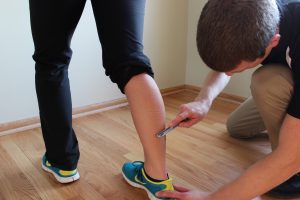Foam Rolling – Top 3 Mistakes And How To Fix Them

Top 3 Foam Rolling Mistakes (And How To Fix Them)
If you have been exercising long enough or training hard enough, at some point you have probably experienced an injury. For many of us who like to think of ourselves as athletes, foam rolling is a must for injury prevention and recovery. As far as which injuries you have experienced depends largely on the activity you were engaged in when the injury occurred. While a runner is most likely to experience Achilles tendinitis, IT-band syndrome, or plantar fasciitis, a CrossFitter or weightlifter is much more likely to experience shoulder pain, low back pain, or elbow pain.
Regardless of your preferred activity or injury, there are self-treatments that can be performed to speed recovery. Our sports chiropractors can help you recovery faster and give you specific home care recommendations to minimize your downtime and get you back to pushing your limits.
Foam Rolling Benefits
 The American Council on Exercise (ACE) published six benefits provided by foam rolling.
The American Council on Exercise (ACE) published six benefits provided by foam rolling.
- Reduce the risk of developing adhesions or collagen binding between layers of muscle.
- Reduce tissue tension and muscle tightness to increase joint range of motion (ROM).
- Restore the proper length-tension relationship to muscle groups that work together.
- Reduce soreness after an exercise session to promote the recovery process.
- Help increase blood flow and elevate heat in the involved tissue.
- Promote a feeling of relaxation after a workout, an important psychological benefit.
For all of these reasons many athletes find regular foam rolling sessions allow them to achieve higher levels of recovery and performance. However, as with many recovery or performance-related activities performing foam rolling the wrong way can cause more detriment than improvement.
Top 3 Foam Rolling Mistakes
Over the years we have seen some interesting things with a foam roller. However, here are the top 3 issues we see people doing incorrectly.
1. No pain, no gain!
While foam rolling is not always the most pleasant activity to perform, the goal should not be to inflict the maximum amount of pain on yourself. The goal of foam rolling is to rehydrate tissue and reduce muscle tension. When the brain experiences pain, it tells the muscles in that area to contract as a protective mechanism. This is counterproductive and does not allow for tissue relaxation.
Gently ease into the tighter areas with slow and long passes on the foam roller. As the entire muscle begins to loosen up, you can start to focus on more of the trigger points with a focused and intentional pressure in certain areas.
2. Rushing through it.
Most of us have a limited amount of time in our day for exercise and working out. After the workout or run we want to spend the minimal amount of time possible to get the maximum benefit on recovery. This may mean only stretching our “problem areas” and skipping the rest, or flying through a foam rolling session that is too short and too aggressive (see #1).
Try transferring 5 minutes from your workout to recovery time each day for one week. Take a slow and controlled approach to stretching and foam rolling. This helps effectively rehydrate the affected tissue and loosen tight muscle groups. Pay attention to, or even document, how you feel after workouts and more importantly the next day or heading into the next workout. You might be surprised at the difference a small amount of time like 5 minutes can make!
3. Lack of focus.
Building off number 1 and 2, have a plan when foam rolling. You wouldn’t go into a 5k or marathon without a training plan or pay for a personal trainer who does no programming. So take recovery as seriously as the workout, because they are different pieces to the same training puzzle. Be intentional with the foam rolling and make sure you actually feel better or looser after you are finished.
Also be sure to foam roll up and down the kinetic chain. For example, if your hamstring is tight and sore after a run, roll through the calf muscles on that side, the hamstring, and also up into the glutes on that side.
How Sports Chiropractors Can Help
 Foam rolling is an incredible tool to assist with recovery and injury prevention, however if you’ve been doing it for a while and your pain still persists, there may be an underlying movement issue or injury. Our sports chiropractors have extensive training in diagnosing and treating soft tissue injuries. If your injury is persisting beyond two weeks, it is most likely time for some professional help. This minimizes your time missing training and gets you back on track faster. For more information about our treatment options and techniques visit our sports chiropractic and Graston Technique pages.
Foam rolling is an incredible tool to assist with recovery and injury prevention, however if you’ve been doing it for a while and your pain still persists, there may be an underlying movement issue or injury. Our sports chiropractors have extensive training in diagnosing and treating soft tissue injuries. If your injury is persisting beyond two weeks, it is most likely time for some professional help. This minimizes your time missing training and gets you back on track faster. For more information about our treatment options and techniques visit our sports chiropractic and Graston Technique pages.
You can also schedule a free consultation or new patient appointment online or call 262-373-9168.
 262-373-9168
262-373-9168



